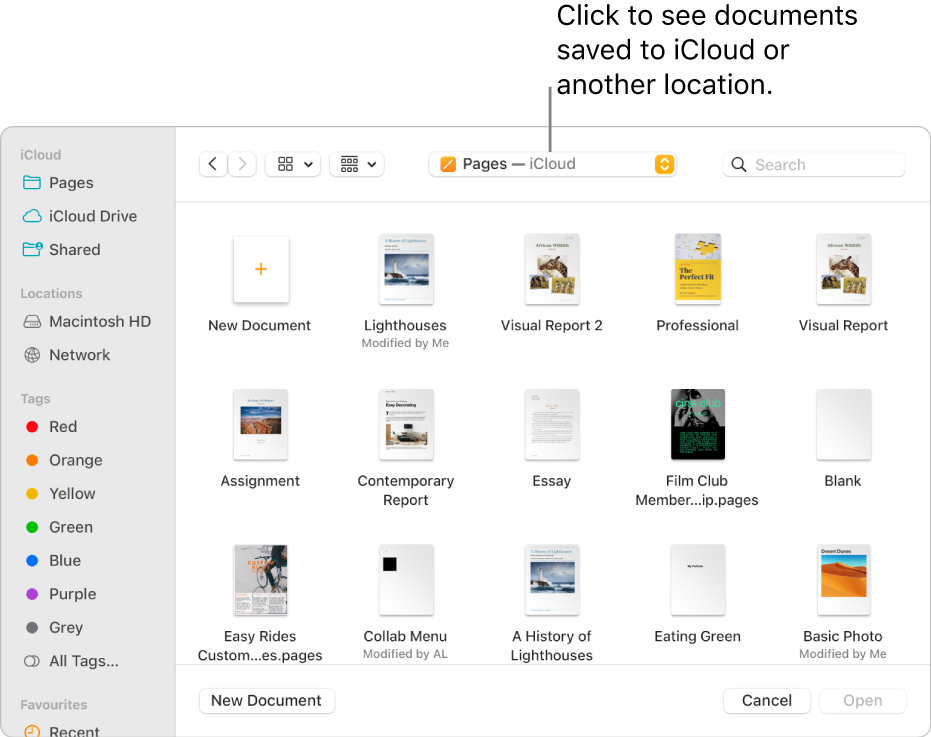
Open or close a document in Pages on Mac
You can open Pages documents saved on your Mac, in iCloud Drive, on connected servers and in third-party storage providers. If you can’t open a Pages document, make sure that you have the latest version of Pages from the Mac App Store. If a document is dimmed and can’t be selected, it means the document can’t be opened by Pages.
You can open and edit Microsoft Word documents (files with a .doc or .docx filename extension), iBooks Author books (files with a .iba filename extension), and text documents (files with a .rtf or .txt filename extension) in Pages, then save them as Pages or Word documents, or in PDF or EPUB formats.
Open an existing document in Pages
Go to the Pages app
 on your Mac.
on your Mac.Do one of the following:
Open a document on a Mac: For a Pages document, double click the document name or thumbnail or drag it to the Pages icon in the Dock or Applications folder. For a Word document, drag it to the Pages icon (double clicking the file opens Word if you have that app). You can’t open PDFs in Pages.
Open a document you recently worked on: Choose File > Open Recent (from the File menu at the top of your screen). Pages shows up to the last ten documents you opened.
Open a document stored somewhere other than your Mac (such as iCloud Drive): Choose File > Open (from the File menu at the top of your screen). In the dialogue, click a location in the sidebar on the left or click the pop-up menu at the top of the dialogue, then choose the location where the document is saved. Double click the document to open it.

When you open a document that uses fonts not installed on your computer, a missing font notification appears briefly at the top of the document. To see which fonts are missing and to choose replacements, click the notification or (if the notification is no longer visible) choose Format > Font > Replace Fonts. To learn more, see Replace fonts.
You can use Font Book, available in the Applications folder on your Mac, to install fonts you purchase or download. See the Font Book User Guide for instructions.
Note: Some templates aren’t downloaded to your computer until you choose them or open a document that uses the template. If your connection is slow or you’re offline when this happens, placeholder images in the document may appear at a lower resolution until you’re online again or the template finishes downloading.
Open documents in tabs
You can have more than one Pages document open at a time. When you work in multiple documents, it’s helpful to open them in tabs rather than in separate windows — that way, you can move between them by clicking the tabs in the tab bar.
On your Mac, choose Apple menu

Go to Windows, click the pop-up menu next to “Prefer tabs when opening documents”, then choose Always or In Full Screen.
This setting applies not just to documents in Pages, but also to documents in other applications such as TextEdit, Numbers and Keynote.
Go to the Pages app
 on your Mac, then open two or more documents.
on your Mac, then open two or more documents.Do any of the following:
View a different document: Click the tab with the document’s title.
Close a document: Move the pointer over the document’s tab, then click the
 in the corner of the tab.
in the corner of the tab.Add an open document to the tab bar: Drag the document onto the tab bar.
Move an open document out of the tab bar: Drag a tab to the side of the Pages window to open the document in its own Pages window.
Note: If you already have multiple documents open in separate windows and you want to merge them into a single window with tabs, choose Window > Merge All Windows.
Close a document
Do one of the following:
Go to the Pages app
 on your Mac.
on your Mac.Do one of the following:
Close a document but keep Pages open: Click the red close button in the top-left corner of the Pages window or press Command-W.
Close the document and quit Pages: Select Pages > Quit Pages (from the Pages menu at the top of your screen). All your changes are saved.